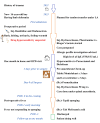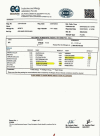Perioperative Management Conundrum for a Case With Multiple Commonly Used Drug Hypersensitivity
- PMID: 38410320
- PMCID: PMC10895081
- DOI: 10.7759/cureus.53015
Perioperative Management Conundrum for a Case With Multiple Commonly Used Drug Hypersensitivity
Abstract
Perioperative hypersensitivity reactions vary from mild to potentially fatal anaphylaxis, resulting in significant morbidity and mortality. Most of the perioperative hypersensitivity and allergic reactions are attributed to antibiotics, antiseptic solutions, latex, and opioids. In the current thrust for opioid-free anesthesia, owing to its multiple advantages, paracetamol and nonsteroidal antiinflammatory agents play a significant role in multi-modal pain and inflammatory response management. Nearly nine out of ten individuals experience postoperative pain, one-third experience postoperative nausea and vomiting, and one-fourth experience fever, irrespective of surgery and type of anesthesia, often as an inflammatory response. While perioperative hypersensitivity reactions are common, a patient allergic to multiple commonly used drugs for the treatment of pain, fever, acid-peptic disorder, and nausea and vomiting is scarce. Such cases pose a great challenge in perioperative management. A 14-year-old male child with a traumatic foot drop planned for tibialis posterior tendon transfer developed an allergic reaction with mild fever following an injection of Ranitidine and Ondansetron in the preoperative area. Surgery was deferred and was investigated for allergy profile testing for commonly used drugs, which showed high IgE levels and moderate to severe hypersensitivity for diclofenac and paracetamol. The patient was operated on after one month under spinal anesthesia, avoiding ranitidine, ondansetron, diclofenac, and paracetamol. The following morning, he developed a high-grade fever (102.3° F), which did not resolve with conservative measures. Hypersensitivity and allergic reactions to NSAIDs are reported in the literature. While there are multiple drugs available as NSAIDs, cross-sensitivity or allergy to other drugs within the same group, and even chemically related groups, is also another possibility that needs to be considered while managing such patients. Mefenamic acid controlled the fever, and the child was discharged home after 48 hours of observation. However, the case posed a great perioperative management dilemma; the present report intends to highlight and discuss it.
Keywords: anaesthesia and analgesia; diclofenac allergy; drug hypersensitivity reactions; mefenamic acid; paracetamol allergy.
Copyright © 2024, Bansal et al.
Conflict of interest statement
The authors have declared that no competing interests exist.
Figures
Similar articles
-
Postoperative analgesia and vomiting, with special reference to day-case surgery: a systematic review.Health Technol Assess. 1998;2(12):1-236. Health Technol Assess. 1998. PMID: 10103349
-
Effectiveness of ondansetron as an adjunct to lidocaine intravenous regional anesthesia on tourniquet pain and postoperative pain in patients undergoing elective hand surgery: a systematic review protocol.JBI Database System Rev Implement Rep. 2015 Jan;13(1):27-38. doi: 10.11124/jbisrir-2015-1768. JBI Database System Rev Implement Rep. 2015. PMID: 26447005
-
[Standard technical specifications for methacholine chloride (Methacholine) bronchial challenge test (2023)].Zhonghua Jie He He Hu Xi Za Zhi. 2024 Feb 12;47(2):101-119. doi: 10.3760/cma.j.cn112147-20231019-00247. Zhonghua Jie He He Hu Xi Za Zhi. 2024. PMID: 38309959 Chinese.
-
Perioperative hypersensitivity reactions during childhood and outcomes of subsequent anesthesia.Paediatr Anaesth. 2021 Apr;31(4):436-443. doi: 10.1111/pan.14126. Epub 2021 Feb 11. Paediatr Anaesth. 2021. PMID: 33423333
-
Perioperative allergy: risk factors.Int J Immunopathol Pharmacol. 2011 Jul-Sep;24(3 Suppl):S27-34. doi: 10.1177/03946320110240s305. Int J Immunopathol Pharmacol. 2011. PMID: 22014923 Review.
References
-
- Perioperative immediate hypersensitivity incidence, clinical characteristics, and outcomes after allergological evaluation: A multi-disciplinary protocol from tertiary hospital, Thailand. Krikeerati T, Wongsa C, Thongngarm T, et al. Asian Pac J Allergy Immunol. 2023 - PubMed
-
- The conundrum of perioperative management for emergency cesarean section in a patient with anaphylactic shock. Poonuraparampil JA, Karim HR, Garhwal A, Babu MJ. Bali J Anesthesiol. 2020;4(Suppl 2):0.
-
- Incidence, patient satisfaction, and perceptions of post-surgical pain: results from a US national survey. Gan TJ, Habib AS, Miller TE, White W, Apfelbaum JL. Curr Med Res Opin. 2014;30:149–160. - PubMed
-
- Early postoperative fever and the "routine" fever work-up: results of a prospective study. Lesperance R, Lehman R, Lesperance K, Cronk D, Martin M. J Surg Res. 2011;171:245–250. - PubMed
Publication types
LinkOut - more resources
Full Text Sources


